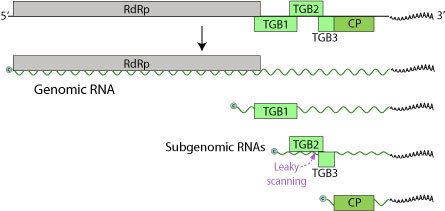Group Group IV ((+)ssRNA) Rank Genus | ||
 | ||
Lower classifications | ||
Potexvirus is a genus of pathogenic viruses in the order Tymovirales, in the family Alphaflexiviridae. Plants serve as natural hosts. There are currently 37 species in this genus including the type species Potato virus X. Diseases associated with this genus include: mosaic and ringspot symptoms. The genus name comes from the type species POTato Virus X).
Contents
Taxonomy
Group: ssRNA(+)
Virology
The virion length may vary considerably (between 470-1000 nanometers or more) and is 12-13 nm in diameter. The pitch of the helix is of the basic helix 3.3-3.7 nm (8-9 copies of the coat protein per turn). It is non-enveloped, flexuous and filamentous. The coat itself is composed of 1000-1500 copies of the coat protein.
The genome is linear, 5.9-7 kilobases in length with a capped 5' end and a polyadenylated 3' end. The genome encodes 5 proteins. From left to right these proteins are: the viral replication protein that consists of a capping enzyme domain, a helicase-like domain, the RNA dependent RNA polymerase, three proteins - the triple gene block (TGB) 1, 2 and 3 - and the coat protein.
The RNA is translated giving rise to the viral RNA polymerase. This in turn produces a negative stranded template from which a series of subgenomic RNAs are generated. These subgenomic RNAs are then translated into the viral proteins.
The 5' end is about 80 nucleotides in length and typically begins with the sequence GAAAA.
In addition to its RNA polymerase activity, the viral RNA polymerase (molecular weight ~150 kiloDaltons) also has methyltransferase and RNA helicase activities.
The TGB proteins are conserved among the Allexivirus, Carlavirus, Foveavirus, Furovirus, Hordeivirus, Pecluvirus, Pomovirus and Potexvirus genera. Their functions are a matter of active research.
TGB 1 (molecular weight 23 kDa) is a multifunctional protein. It has RNA helicase activity and seems to be involved in cell to cell movement.
The TGB 2 (molecular weight 11 kDa) and TGB 3 (molecular weight 10 kDa) proteins associate with the endoplasmic reticulum.
The coat protein has a molecular weight of ~25kDa.
The 3' untranslated region is ~100 nucleotides in length.
Life Cycle
Viral replication is cytoplasmic. Entry into the host cell is achieved by penetration into the host cell. Replication follows the positive stranded RNA virus replication model. Positive stranded RNA virus transcription is the method of transcription. Translation takes place by leaky scanning. The virus exits the host cell by tripartite non-tubule guided viral movement. The virus is transmitted via a vector (insects). Transmission routes are vector and mechanical.
Hosts
Known hosts are from the Liliopsida or Magnoliopsida.
Viral distribution
These viruses appear to occur world wide.
